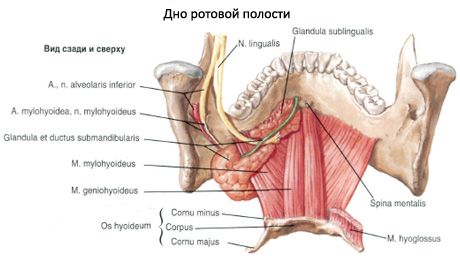Submandibular salivary gland
Last reviewed: 18.10.2021

All iLive content is medically reviewed or fact checked to ensure as much factual accuracy as possible.
We have strict sourcing guidelines and only link to reputable media sites, academic research institutions and, whenever possible, medically peer reviewed studies. Note that the numbers in parentheses ([1], [2], etc.) are clickable links to these studies.
If you feel that any of our content is inaccurate, out-of-date, or otherwise questionable, please select it and press Ctrl + Enter.
The submandibular salivary gland (glandula submandibularis) is a paired, mixed-type secretion that has a thin capsule. It is located in the region of the eponymous neck triangle. Outside, the superficial plate of the cervical fascia and the skin adhere to the gland. The inner surface of the gland comes in contact with the sublingual-lingual and silo-lingual muscles. From the top of the iron reaches the inner surface of the body of the lower jaw.
The upper edge of the gland adjoins the lower jaw, and the upper surface - to the jaw-hyoid muscle. Having rounded the posterior edge of this muscle, the submaxillary salivary gland is located on its upper surface and comes into contact with the posterior-surface surface of the hyaluronic SJ. At the rear edge, the submaxillary salivary gland reaches the capsule of the parotid gland and the medial pterygoid muscle. The outlet duct starts from the uppermost edge of the gland, then penetrates into the gap between the maxillofacial and sublingual-lingual muscles. Along the inner surface of the hyoid drape, the excretory duct extends anteriorly and upward and opens in the anterior part of the bottom of the oral cavity on the hyoid papilla.
The submandibular salivary gland is surrounded on all sides by a capsule, which is formed by the surface plate of the cervical fascia. The latter, splitting, forms a vagina for the submandibular SC, the outer plate of which is attached to the lower edge of the lower jaw, the inner plate is attached to the line of attachment of the maxillofacial muscle. Between the submandibular SC and the vagina is a layer of loose fiber. The submandibular space from below is limited by the superficial leaflet of its own fascia of the neck, from above - by the fascial case of the maxillofacial muscle, the loose fascia covering the sublingual-lingual muscle, and the upper constrictor of the pharynx. From the submandibular space, the pathological process extends into the anterior section of the hypoglossal space and the sublingual cell space. Distribution to the parotid cellular space is prevented by a strong aponeurosis, which comes from the chest of the sternocleidomastoid muscle to the corner of the lower jaw. In this closed space there are also the facial artery, anterior facial vein, and lymph nodes. The latter collect lymph from the upper and lower lips, mouth cavity, tongue, lower jaw, pharynx.
The anterior part of the gland comes into contact with the posterior margin of the jaw-hyoid muscle. The lateral surface of the gland is attached to the facial artery and vein, and also adjacent to the lymph nodes of the same name. The varton duct of the gland (ductus submandibularis) is directed forward, is attached to the sublingual salivary gland and opens by the mouth on the hyoid papilla, next to the frenum of the tongue.

Innervation: secretory (parasympathetic) - fibers of the facial nerve - from the drum string and the submandibular junction, sympathetic - from the outer carotid plexus.
In the submandibular case, a sublingual nerve (XII pair of cranial nerves) that accompanies the lingual vein passes somewhat higher (2-8 mm) in the posterior abdomen of the digastric muscle.
A sensitive lingual nerve passes through the upper section of the submandibular triangle.
The submandibular salivary gland is innervated by chorda tympani (from the anterior part of the bottom of the oral cavity, through the facial nerve) through the submandibular ganglion and the sympathetic nerves accompanying the facial artery. Outflow of lymph occurs to the lymph nodes at the lower pole of the parotid salivary gland and to the deep jugular lymph nodes.
Blood supply: glandular branches of the facial artery. Venous outflow: submandibular vein.
The facial artery, being a branch of the external carotid artery, passes into the submandibular triangle from beneath the posterior abdomen of the digastric muscle and the styloid-hyoid muscle and penetrates the submandibular SJ at its posterior margin. At the level of the anterior edge of the masticatory muscle, the facial artery emerges from the gland on the face, bending over the edge of the lower jaw (here its pulsation is easy to feel).
Blood is submerged in the submandibular salivary gland due to the branches of the facial, lingual and chin arteries. The venous network in this area is formed by anterior facial and supramaxillary veins that flow into the common facial vein. The anterior facial vein accompanies the facial artery, at the lower edge of the lower jaw is located behind the artery, penetrates the glandular capsule and goes along its front surface.
Outflow of lymph: in the submandibular lymph nodes.
What do need to examine?

